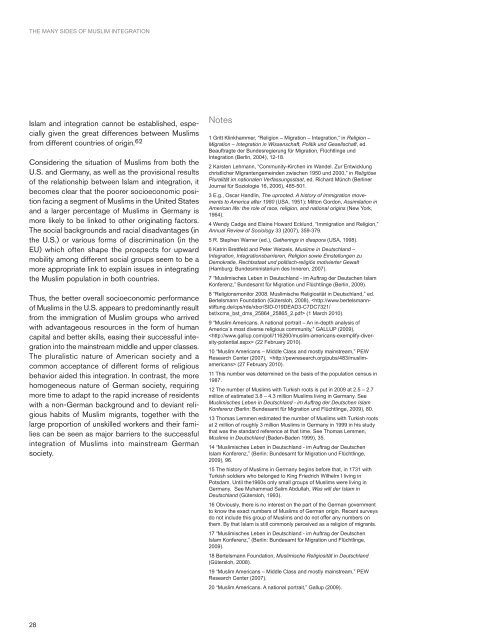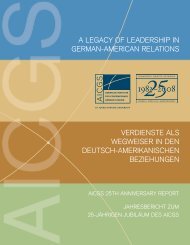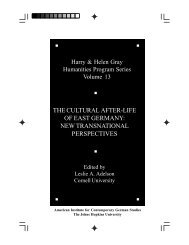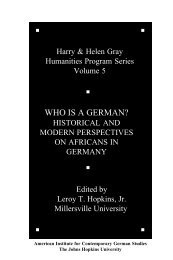the many sides of muslim integration: a german- american - aicgs
the many sides of muslim integration: a german- american - aicgs
the many sides of muslim integration: a german- american - aicgs
You also want an ePaper? Increase the reach of your titles
YUMPU automatically turns print PDFs into web optimized ePapers that Google loves.
<strong>the</strong> <strong>many</strong> <strong>sides</strong> <strong>of</strong> <strong>muslim</strong> <strong>integration</strong><br />
Islam and <strong>integration</strong> cannot be established, especially<br />
given <strong>the</strong> great differences between Muslims<br />
from different countries <strong>of</strong> origin. 62<br />
Considering <strong>the</strong> situation <strong>of</strong> Muslims from both <strong>the</strong><br />
U.S. and Ger<strong>many</strong>, as well as <strong>the</strong> provisional results<br />
<strong>of</strong> <strong>the</strong> relationship between Islam and <strong>integration</strong>, it<br />
becomes clear that <strong>the</strong> poorer socioeconomic position<br />
facing a segment <strong>of</strong> Muslims in <strong>the</strong> United States<br />
and a larger percentage <strong>of</strong> Muslims in Ger<strong>many</strong> is<br />
more likely to be linked to o<strong>the</strong>r originating factors.<br />
The social backgrounds and racial disadvantages (in<br />
<strong>the</strong> U.S.) or various forms <strong>of</strong> discrimination (in <strong>the</strong><br />
EU) which <strong>of</strong>ten shape <strong>the</strong> prospects for upward<br />
mobility among different social groups seem to be a<br />
more appropriate link to explain issues in integrating<br />
<strong>the</strong> Muslim population in both countries.<br />
Thus, <strong>the</strong> better overall socioeconomic performance<br />
<strong>of</strong> Muslims in <strong>the</strong> U.S. appears to predominantly result<br />
from <strong>the</strong> immigration <strong>of</strong> Muslim groups who arrived<br />
with advantageous resources in <strong>the</strong> form <strong>of</strong> human<br />
capital and better skills, easing <strong>the</strong>ir successful <strong>integration</strong><br />
into <strong>the</strong> mainstream middle and upper classes.<br />
The pluralistic nature <strong>of</strong> American society and a<br />
common acceptance <strong>of</strong> different forms <strong>of</strong> religious<br />
behavior aided this <strong>integration</strong>. In contrast, <strong>the</strong> more<br />
homogeneous nature <strong>of</strong> German society, requiring<br />
more time to adapt to <strong>the</strong> rapid increase <strong>of</strong> residents<br />
with a non-German background and to deviant religious<br />
habits <strong>of</strong> Muslim migrants, toge<strong>the</strong>r with <strong>the</strong><br />
large proportion <strong>of</strong> unskilled workers and <strong>the</strong>ir families<br />
can be seen as major barriers to <strong>the</strong> successful<br />
<strong>integration</strong> <strong>of</strong> Muslims into mainstream German<br />
society.<br />
28<br />
Notes<br />
1 gritt Klinkhammer, “religion – migration – <strong>integration</strong>,“ in Religion –<br />
Migration – Integration in Wissenschaft, Politik und Gesellschaft, ed.<br />
Beauftragte der Bundesregierung für migration, flüchtlinge und<br />
<strong>integration</strong> (Berlin, 2004), 12-18.<br />
2 Karsten lehmann, “Community-Kirchen im Wandel. Zur entwicklung<br />
christlicher migrantengemeinden zwischen 1950 und 2000,” in Religiöse<br />
Pluralität im nationalen Verfassungsstaat, ed. richard münch (Berliner<br />
Journal für soziologie 16, 2006), 485-501.<br />
3 e.g., oscar handlin, The uprooted. A history <strong>of</strong> immigration movements<br />
to America after 1980 (usa, 1951); milton gordon, Assimilation in<br />
American life: <strong>the</strong> role <strong>of</strong> race, religion, and national origins (new york,<br />
1964).<br />
4 Wendy Cadge and elaine howard ecklund, “immigration and religion,”<br />
Annual Review <strong>of</strong> Sociology 33 (2007), 359-379.<br />
5 r. stephen Warner (ed.), Ga<strong>the</strong>rings in diaspora (usa, 1998).<br />
6 Katrin Brettfeld and Peter Wetzels, Muslime in Deutschland –<br />
Integration, Integrationsbarrieren, Religion sowie Einstellungen zu<br />
Demokratie, Rechtsstaat und politisch-religiös motivierter Gewalt<br />
(hamburg: Bundesministerium des inneren, 2007).<br />
7 “<strong>muslim</strong>isches leben in deutschland - im auftrag der deutschen islam<br />
Konferenz,” Bundesamt für migration und flüchtlinge (Berlin, 2009).<br />
8 “religionsmonitor 2008. <strong>muslim</strong>ische religiosität in deutschland,” ed.<br />
Bertelsmann foundation (gütersloh, 2008), (1 march 2010).<br />
9 “<strong>muslim</strong> <strong>american</strong>s. a national portrait – an in-depth analysis <strong>of</strong><br />
america´s most diverse religious community,” galluP (2009),<br />
<br />
(22 february 2010).<br />
10 “<strong>muslim</strong> <strong>american</strong>s – middle Class and mostly mainstream,” PeW<br />
research Center (2007), <br />
(27 february 2010).<br />
11 this number was determined on <strong>the</strong> basis <strong>of</strong> <strong>the</strong> population census in<br />
1987.<br />
12 <strong>the</strong> number <strong>of</strong> <strong>muslim</strong>s with turkish roots is put in 2009 at 2.5 – 2.7<br />
million <strong>of</strong> estimated 3.8 – 4.3 million <strong>muslim</strong>s living in ger<strong>many</strong>. see<br />
Muslimisches Leben in Deutschland - im Auftrag der Deutschen Islam<br />
Konferenz (Berlin: Bundesamt für migration und flüchtlinge, 2009), 80.<br />
13 thomas lemmen estimated <strong>the</strong> number <strong>of</strong> <strong>muslim</strong>s with turkish roots<br />
at 2 million <strong>of</strong> roughly 3 million <strong>muslim</strong>s in ger<strong>many</strong> in 1999 in his study<br />
that was <strong>the</strong> standard reference at that time. see thomas lemmen,<br />
Muslime in Deutschland (Baden-Baden 1999), 35.<br />
14 “<strong>muslim</strong>isches leben in deutschland - im auftrag der deutschen<br />
islam Konferenz,” (Berlin: Bundesamt für migration und flüchtlinge,<br />
2009), 96.<br />
15 <strong>the</strong> history <strong>of</strong> <strong>muslim</strong>s in ger<strong>many</strong> begins before that, in 1731 with<br />
turkish soldiers who belonged to King friedrich Wilhelm i living in<br />
Potsdam. until <strong>the</strong>1960s only small groups <strong>of</strong> <strong>muslim</strong>s were living in<br />
ger<strong>many</strong>. see muhammad salim abdullah, Was will der Islam in<br />
Deutschland (gütersloh, 1993).<br />
16 obviously, <strong>the</strong>re is no interest on <strong>the</strong> part <strong>of</strong> <strong>the</strong> <strong>german</strong> government<br />
to know <strong>the</strong> exact numbers <strong>of</strong> <strong>muslim</strong>s <strong>of</strong> <strong>german</strong> origin. recent surveys<br />
do not include this group <strong>of</strong> <strong>muslim</strong>s and do not <strong>of</strong>fer any numbers on<br />
<strong>the</strong>m. By that islam is still commonly perceived as a religion <strong>of</strong> migrants.<br />
17 “<strong>muslim</strong>isches leben in deutschland - im auftrag der deutschen<br />
islam Konferenz,” (Berlin: Bundesamt für migration und flüchtlinge,<br />
2009).<br />
18 Bertelsmann foundation, Muslimische Religiosität in Deutschland<br />
(gütersloh, 2008).<br />
19 “<strong>muslim</strong> <strong>american</strong>s – middle Class and mostly mainstream,” PeW<br />
research Center (2007).<br />
20 “<strong>muslim</strong> <strong>american</strong>s. a national portrait,” gallup (2009).





